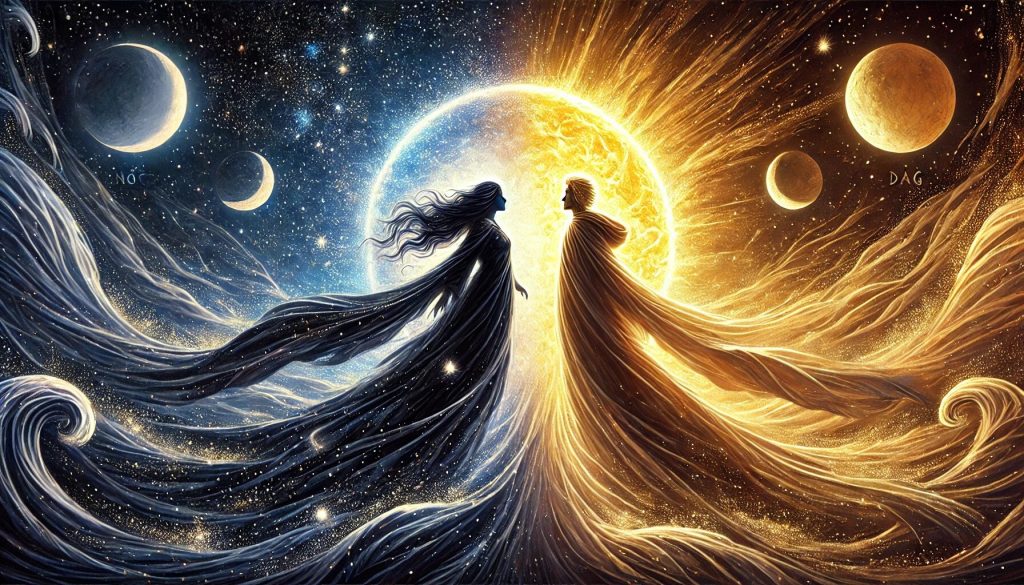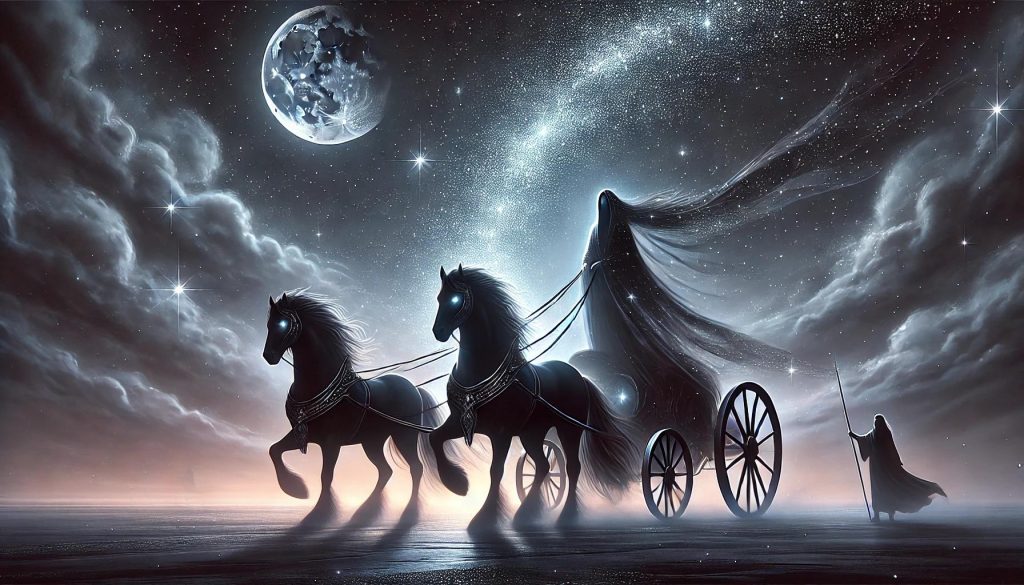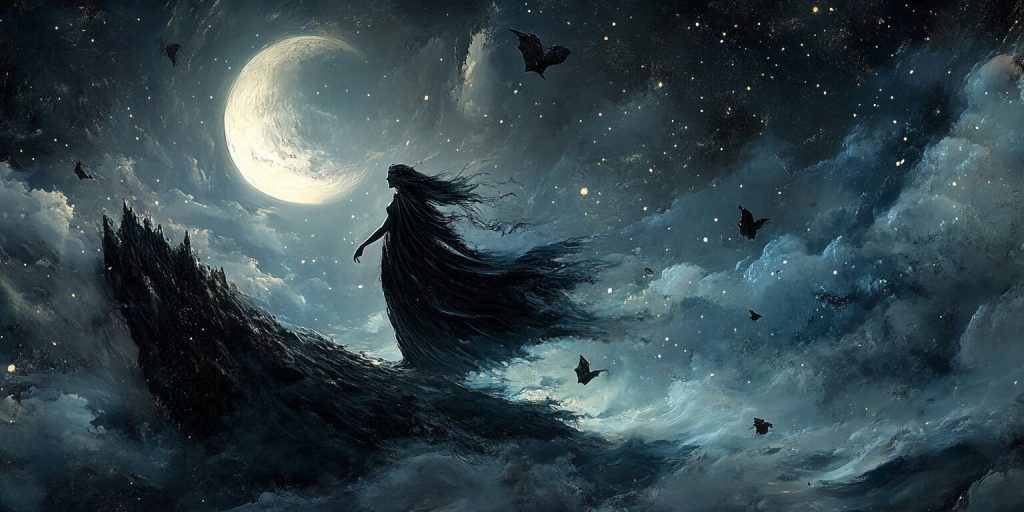Norse Goddesses, Norse Gods, Norse Mythology
Norse God of Night: The Mysterious Figure in Viking Legends
The Norse god of night is a fascinating figure in Viking stories. Nótt, the goddess of night, shows the beauty of darkness in Norse myths, serving as a dream goddess. She is a key part of nature’s cycle and the secrets of the night.
Her stories are linked to Dagr, the god of day. Old texts like the Prose Edda and Poetic Edda teach us about her importance as a Norse deity and her place in the balance of night and day.
Introduction to Norse Mythology
Norse mythology is filled with stories showing the Viking age’s spirit, including tales of Dellingr and the day-and-night cycle. These tales come from Northern Europe and are found in old texts like the Poetic Edda and Prose Edda. They include references to the dream goddess. They tell of Norse gods and goddesses and their battles with giants, known as jötunn.
The myths extensively discuss creation and destruction. This shows how the Norse people saw time as a cycle, which the chariot of Nótt can personify. Gods like Odin and Thor show the world’s balance of power and wisdom. Goddesses like Nótt, who rules the night, add to the story’s depth, including her relationship with Narfi.
Looking into these myths helps us understand the Norse view of the universe. They saw the world as a mix of light and dark, life and death, all connected through their gods and goddesses.
Nátt: The Norse Goddess of Night
Nátt is the goddess of night in Norse mythology. She represents the deep mysteries of darkness. Often shown in dark robes, she stands for the vast night sky.
She is a key figure in Norse mythology. Nótt marks the start of night, balancing day and night.
Nátt and her son Dagr show the cycle of light and dark. This cycle is crucial to Norse time and life and reflects the themes found in alvíssmál. Nótt’s family ties include jötunn, showing her importance in Norse stories.

- Embodiment of darkness
- Contrast with daylight through her son Dagr
- The key figure in creation myths
Nótt’s role in Norse mythology is vital, as she personifies the essence of night. She shows the balance of light and dark in the universe, embodying the personification of the night.
Norse Word for Night and Its Significance
The Old Norse term “nótt” is more than just a word for night. It holds deep meanings that show the Vikings’ connection to darkness. This word’s roots come from Germanic languages, showing its value across cultures.
The Linguistic Roots of “Nótt”
Looking into “nótt” reveals how ancient people saw time and nature. It’s not just about night in Norse myths. It also shows the shared roots of Indo-European languages, connecting them to the stories of night in Norse mythology. Words like it exist in other Germanic languages, showing night’s universal importance.
Cultural Impact of the Word
The word “nótt” deeply affects Norse literature, art, and stories. Night in Norse tales is a time for thinking, dreaming, and meeting the supernatural. Stories of Nótt’s journey through the sky show the importance of night.
These stories help us understand the Viking Age better by showing how night shaped the Vikings’ spiritual and cultural lives.
The Role of Nótt in Norse Literature
Nótt is very important in Norse literature. She adds depth to stories in the Poetic Edda and the Prose Edda. These texts give us a deep look into her character and her ties with the Norse gods and the universe.
References in the Poetic Edda
The Poetic Edda talks a lot about Nótt. She is a key figure in these stories. They show her travels and how she meets other beings, including elves, showing her importance in the day and night cycle.
These stories use beautiful words and exciting tales to show who Nótt is. They talk about her battles against light and her peace with nature. This shows the deep themes in Norse myths. The stories come from old traditions, showing the culture of the time.
Significance in the Prose Edda
The Prose Edda goes deeper into Nótt’s role in Norse myths, exploring her connections to other beings like elves and dwarfs. It talks about her family and her connections to the gods. Nótt is seen as a key to keeping the balance of day and night.
Her stories show her fighting and her peace with gods, which shows her big role in Norse stories. Reading about Nótt helps us understand the lasting stories of Norse myths.
Norse God of Night: Relationships and Family
Norse mythology shows us the goddess of night, Nótt, and her family. She is the Norse god of night. Her son Dagr, who is day, is her most important connection. This shows the balance of nature and Nótt’s key role in it.
Nótt’s family goes beyond her son Dagr. She married many gods, showing how gods are connected. Each marriage had children and made important connections in Norse mythology. This shows how relationships link gods together.
- Nótt’s marriage to Naglfari gave her Dagr, showing light and dark.
- Her marriages to other gods show the complex divine relationships and their effects on the world.
These family ties help us understand Nótt in Norse mythology. They show how family and relationships are key, making Norse myths rich and meaningful.
The Personification of Night in Viking Culture
In Viking culture, Nótt and her son Dagr show the balance of night and day. They help us see how night turns into day in a never-ending cycle. This way, the Norse people could understand and connect with their world.
Stories of Nótt and Dagr show their big role in Norse stories. They teach us about the natural order, much like the lessons found in vafþrúðnismál.
Understanding Nótt and Her Son Dagr
Nótt is night, and her son Dagr is daylight. Their story shows how both are key in Norse myths. It tells us how day and night keep the world in balance, much like the cycle of auðr and prosperity.
Their story also discusses time going in circles, an idea popular in Norse lore. It shows how night turning to day means new beginnings.
Nótt’s Marriages and Their Symbolism
Nótt married Vafþrúðnir and Annar, adding to her story. These marriages had important kids and were key in Norse myths. Nótt’s marriages show themes of sacrifice, duty, and harmony.
These stories show how personal ties shape the divine world and reveal the deep connections in the universe, like in Norse myths.
The Chariot of Nótt: A Symbol of Night
In Norse mythology, the chariot of Nótt symbolizes night. Nótt rides it across the sky, indicating the change from day to night and the beauty of night. The Norse people saw this change as a soothing part of life.

As Nótt rides, the beauty and importance of night are shown. The night is a key part of our world.
How Nótt Rides Around the Earth
Nótt travels the heavens in her chariot every night. This journey shows the cycle of light and darkness in life. The people of the North saw Nótt’s chariot as sacred, representing the first marriage of night and day.
Her path across the sky linked human life to the cosmic order. It showed the deep connection between us and the universe.
The Horse Hrímfaxi: Nótt’s Companion
Hrímfaxi, the frosty-maned horse, rides with Nótt. He represents the calm of night. Together, they show the harmony between Nótt and nature.
Hrímfaxi adds depth to Nótt’s story. He shows the importance of animals in Norse beliefs, often standing for divine qualities. Nótt and Hrímfaxi’s journey is a magical tale that fascinates those who explore the cosmos.
Night and Day: The Cosmic Balance
The idea of cosmic balance in Norse mythology is shown through Nótt and Dagr, illustrating their connection to night and darkness. Night and day are key in the Viking world. They show the harmony needed for life to flourish.
Nótt Norse mythology stands for the calm of darkness, while Dagr is the light and energy of day. Together, they keep the natural order going.
Nótt and Dagr’s bond shows the balance in Viking cosmology. Night and day impact life, from farming to daily life. This balance helps us see how ancient Norse societies lived.
Nótt reminds us of the beauty in darkness, where the dew of night sparkles like stars. Unlike the busy day, night brings rest and renewal, highlighting the importance of night and darkness. Nótt and Dagr’s cycle teaches us about balance. It shows the importance of both light and dark in our lives.

